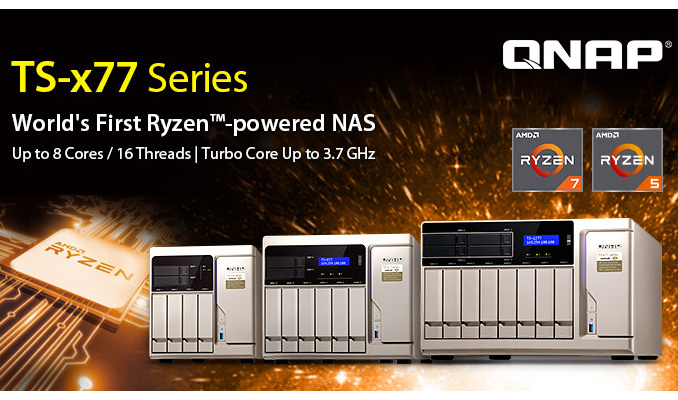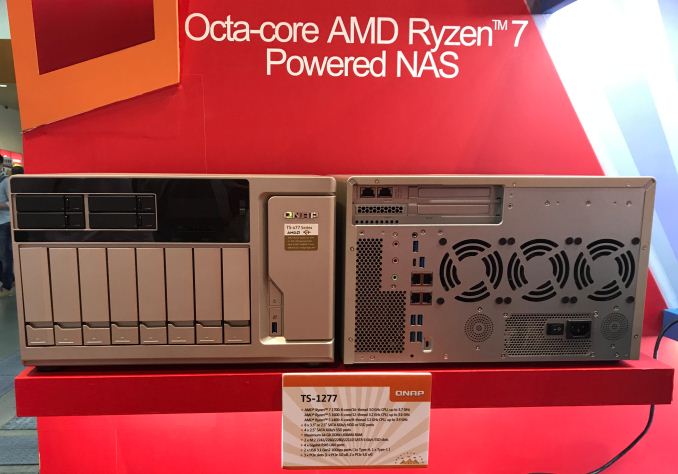QNAP Begins to Ship AMD Ryzen-Based TS-x77 Series NAS: 6, 8, 12 Bays
by Anton Shilov on November 3, 2017 3:00 PM EST
QNAP on Wednesday said that it had begun to ship its NAS devices based on AMD’s Ryzen processors. The new TS-677, TS-877 and TS-1277 NAS feature six, eight, or twelve hard drive bays and support SSD caching to maximize performance. The company positions the new NAS for various demanding applications, including VDI, private cloud, virtualization, containerized applications and so on.
QNAP introduced its TS-x77-series NAS at Computex in mid-2017 and became the first supplier of such products to adopt the AMD Ryzen platform. The company explained that high core count, strong integer performance, versatile PCIe support, AES-NI support, competitive pricing, and other factors made CPU a good choice for NAS. Integrated capabilities of the Ryzen platform enabled QNAP to support two M.2-22110 PCIe 3.0 x4 slots for caching SSDs, two PCIe 3.0 x4 slots as well as a PCIe 3.0 x8 slot for 10GbE/40GbE NICs, PCIe NVMe SSD, graphics and other expansion cards in all three models of the TS-x77 series.
The top-of-the-range 12-bay QNAP TS-1277 NAS is based on AMD’s eight-core Ryzen 7 1700 CPUs and come with 64 GB of DDR4 memory in order to handle various applications. Meanwhile, mid-range and entry-level models featuring 12, 8 or 6 bays use the six-core AMD Ryzen 5-1600 and come with 16 GB or 8 GB of memory (see the table below for specifications of the U.S. versions, for others it makes sense to check out the original news story from Computex). All the QNAP TS-x77-series NAS support RAID 50/60 as well as Qtier 2.0 IO Aware features for SSD tiered storage.
The new NAS will run QNAP’s QTS 4.3 operating system and therefore will support the same capabilities as other NAS from the manufacturer. In addition, the QTS 4.3 supports various specially designed applications. The TS-x77 devices are also virtualization ready for VMware, Citrix, Microsoft Hyper-V and Windows Server 2012 R2 environments with the support of iSER (iSCSI Over RDMA). The powerful CPUs inside enable the NAS to host virtual machines and run various applications.
| QNAP TS-1277, TS-877 and TS-677 Specifications for the U.S. Market | |||||||
| TS-1277- 1700-64G-US |
TS-1277- 1700-32G-US |
TS-1277- 1600-16G-US |
TS-877- 1700-16G-US |
TS-877- 1600-8G-US |
TS-677- 1600-8G-US |
||
| CPU | Model | Ryzen 7 1700 | Ryzen 5 1600 |
Ryzen 7 1700 |
Ryzen 5 1600 | ||
| Cores/ Threads |
8C/16T | 6C/12T | 8C/16T | 6C/12T | |||
| Freq. | 3 - 3.7 GHz | 3.2 - 3.6 GHz | 3 - 3.7 GHz | 3.2 - 3.6 GHz | |||
| L2 Cache | 4 MB | 3 MB | 4 MB | 3 MB | |||
| L3 Cache | 16 MB | 16 MB | 16 MB | 16 MB | |||
| TDP | 65 W | ||||||
| Encryption Acceleration | AES-NI | ||||||
| Memory | Speed | DDR4-2400, dual-channel | |||||
| Capacity | 64 GB (4×16 GB) | 16 GB (2×8 GB) |
8 GB (2×4 GB) |
16 GB (2×8 GB) |
8 GB (2×4 GB) |
||
| Bays | 8 × 3.5" 4 × 2.5" |
6 × 3.5" 2 × 2.5" |
4 × 3.5" 2 × 2.5" |
||||
| M.2 Slots | 2×M.2 slots (up to M.2-22110) | ||||||
| Storage interface | SATA 6 Gbps | ||||||
| Ethernet | 4×GbE, 10/40 GbE supported via add-in-cards | ||||||
| PCIe Slots | 1 × PCIe 3.0 x8 2 × PCIe 3.0 x4 |
||||||
| Audio | 2 speakers 1 × audio out 2 × audio in |
||||||
| USB | 1 × USB 3.1 Type-A 5 × USB 3.0 Type-A 1 × USB 3.1 Type-C |
||||||
| Other I/O | Monochrome backlit LCD display with Enter & Select buttons, 3.5 mm console port, voice allert, buzzer, etc. | ||||||
| Dimensions | Height | 234.6 mm / 9.23" | 231.9 mm / 9.13" | ||||
| Width | 369.9 mm / 14.56" | 292.8 mm / 11.53" | 224.9mm/8.9" | ||||
| Depth | 319.8 mm / 12.59" | ||||||
| PSU | 550 W | 450 W | 250 W | ||||
| OS | QNAP QTS 4.3 | ||||||
| MSRP | $3599 | $2699 | $2299 | $2299 | $1899 | $1699 | |
| Check Availability | Amazon Newegg |
Amazon Newegg |
Amazon Newegg |
Amazon Newegg |
Amazon Newegg |
Amazon Newegg |
|
Originally, QNAP promised to ship the TS-x77 series NAS sometimes in Q3, but then delayed them to November, so expect the products to be available from retailers in the coming couple of weeks. Given the positioning, the new TS-677, TS-877 and TS-1277 NAS from QNAP are not going to be cheap. The manufacturer did not reaffirm pricing of the new units in its recent press release, but based on claims made earlier this year, the most affordable TS-677 (Ryzen 5 1600, 8 GB DDR4, no drives) will retail for $1699, whereas the high-end TS-1277 (Ryzen 7 1700, 64 GB, no drives) will cost $3599. Actual specs and MSRPs may vary by region and fully-populated NAS will naturally cost more.
Related Reading:
- QNAP Launches TS-1277 NAS Powered by AMD's Ryzen CPUs: 12 Bays, 64 GB DDR4, Starts at $2,299
- QNAP at CES 2017 - Thunderbolt 3 and Xeon D NAS Units, Residential Gateways, and More
- Synology at CES 2017 - RT2600ac Wi-Fi Router, DSM Value Additions, and New Business NAS Units
- Netgear Expands ReadyNAS Lineup with Intel Denverton Atom Platform
Source: QNAP











23 Comments
View All Comments
B166ER - Friday, November 3, 2017 - link
In the game of NAS boxes, aren't these a bit overkill?Ratman6161 - Friday, November 3, 2017 - link
Definitely seem like gross overkill to me. I'm assuming they must be aimed at a niche that I don't fit into. One of those things where if you have to ask what its for then you probably don't need it.Ratman6161 - Friday, November 3, 2017 - link
OK, now that I re-read it, it is capable of being a VMWare host so i could see them for that purpose. Thing is I built my own for that purpose for a pile less money. this was a few years ago and I used an 8320 FX on a 990FX motherboard which has plenty of PCIe connectivity. Put an LSI X8 RAID card in there and Intel dual port gigabit card and it cost a whole lot less than $1700. If I was doing it today, I'd probably use an R51600 on a X370 board but the whole thing could be built for under $1K.bill.rookard - Saturday, November 4, 2017 - link
Agreed - my NAS that I have is a 4u rack with some IcyDock bays, and it's on a basic LGA1150 board running a G3240. It also has another pass-through 4 port PCIe->SATA adapter for more drive capability and it runs solid as a rock (basic CentOS system). I'm not sure from a hardware point of view (not counting a custom hot-swap mini-chassis) that these are worth the money, but from a custom software point of view and a 'plug and play' simplicity, I guess that's where most of the value is.However, for those not worried about getting into the CLI for a Linux distro, this would be not a smart use of the money. I think I could build an equivalent system, WITH DRIVES for significantly less cash.
drajitshnew - Monday, November 6, 2017 - link
My guess would be that these have M2 ports & PCIE (for 10 GbE) from the CPU. Plus drivers for non-Win OS. If there is a x370 board with the above specs PLEASE name it. If it's available in India I'll buy it.Oh, the last I checked btrfs does not have an official N-parity raid.
tipoo - Monday, November 6, 2017 - link
If the NAS can run Plex directly, that would be one possible use of a lot of CPU performance.Vatharian - Friday, November 3, 2017 - link
Who the hell needs GPU in a NAS? I don't think deduplication can be accelerated by any GPU... so why?Also Ts-1277 has already 6x ethernet, I guess at elast two of them are 10G. Those two extra PCIe ports for NVMe can get super handy.
Kevin G - Friday, November 3, 2017 - link
People who want to do video recording from camera systems. In some setups, the NAS tackles the encoding process.Vatharian - Friday, November 3, 2017 - link
Seems a little bit strange to me - but I have never stumbled upon such setup. From my experience, it's either IP camera, that sends already encoded (in hardware) stream to the NAS as data stream to sparse file, or analog/digital 'classic' camera with all the RS485 bells and whistles, but those require either dedicated PCI/PCIe card with multiple video inputs that handles encoding in ASIC onboard, or it's whole standalone box, that still sends already encoded stream as file segments.drajitshnew - Monday, November 6, 2017 - link
The specs do NOT list a pcie x16 slots. You might NOT be able to add a gpu.